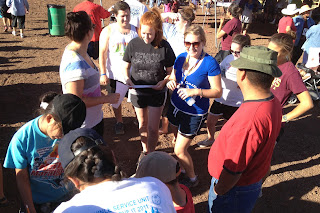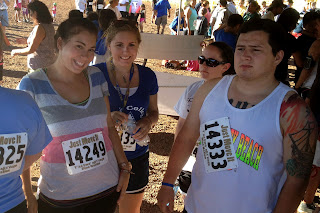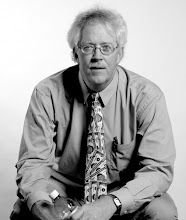The day started with breakfast in the Diné College cafeteria.

The class met in the morning and each student journalism group showed samples of their interviews with Navajo elders recorded over the past 2.5 weeks. Class members offered constructive criticism and helpful suggestions.
Following class most of the journalism teams, made up of Winona State University and Diné College students, met and continued editing and polishing their documentary films on the lives of their elders.
In the early evening, the whole WSU group plus the Haskie family participated in a "Just Move It" event. The Navajo Nation's health promotion program sponsors these events each summer across the reservation. Local families come out and walk 3.5 miles and get a free t-shirt. The Navajo Oral History project group was lucky the Just Move It event tonight was scheduled at the Diné College-Tsaile Campus.


In the evening, everyone was trying to unwind, pack up their clothes and journalism gear, and get ready to return home tomorrow (Thursday, June 21).
There were lots of hugs between the Winona State and Diné College students as they bid farewell. The students will see each other via Interactive Television next week when the class meets several times to view drafts.
In the fall, the students will get together again to celebrate and premiere their documentary films. Receptions will be held at both Winona State University and Diné College, dates to be announced soon.
Friends and loved ones of these students can be proud. It might be a stretch to say the groups operated in total harmony for the entire 2.5 weeks of field work. Even if there were disagreements or equipment malfunctions, the student journalists handled themselves professionally and found ways to be flexible and resourceful so they could complete their important work.
Before this journey started, the WSU students learned of the Navajo concept of Hozho: The Diné concept of balance and harmony. They were reminded to start each day fresh and new, in balance with nature, their classmates and themselves. They were asked to leave differences and difficulties behind them each night in their sleep, and begin each day as an opportunity to live, laugh, love and work in harmony with each other. The group has done remarkably well with this concept.
Another Diné concept learned was that of Nizhoni: Beauty. Everything and everyone is beautiful in their own way. It makes everyone's lives easier and happier if each person looks for the beauty in everything first. It's hard to maintain an ugly thought or a bad mood when you are specifically trying to find beauty in everything and everyone.
This may sound new-agey or preachy... In reality, these concepts are a part of life for most Diné people. One of the main goals of the Navajo Oral History project -- in addition to creating excellent documentaries -- is to gain insight and understanding of a unique culture. The Winona State students learned much from their Diné College partners. At the same time, the Diné students learned by being closely involved with the Winona State students.
On Thursday morning, the vans will be packed with people, luggage and journalism gear as the WSU group heads to the Albuquerque airport, where the students will catch their flights and make their way back home. They'll have the weekend to re-connect with family and friends before reconvening as a class again Monday morning.
To parents, relatives and friends of the students: THANK YOU for sharing these amazing student journalists with the program for the past several weeks. They've worked hard and had fun. Most importantly, they developed as human beings. Need evidence? Ask them what it means to be Navajo in the year 2012. Then just listen.































No comments:
Post a Comment